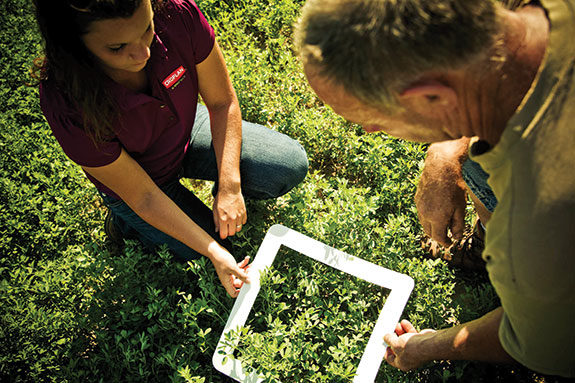Go beneath the soil to determine rotation
The first step for establishing a management plan is to look at the alfalfa rotation. As a rule of thumb, stems are used to evaluate current yield potential, while roots are critical for determining future yield potential
. Digging roots and examining the portion of the alfalfa plant underground is known as “reading the stand.” This plant evaluation method provides valuable insights on current and future stand productivity to help make accurate decisions on when to rotate stands.
A unique stand assessment process utilized by our team includes determining a numeric plant health score and stand density measurement for each field.
To determine plant score, start by randomly digging up a minimum of 10 plants from throughout the field. Once the plants are out of the ground, split the crowns of each plant and visually assess the plant.
Plants are scored on a zero to five scale, with zero representing a healthy plant and five indicating the plant is dead. Once the score for each plant has been determined, calculate the average score for the field.
An average score of greater than two from 10 to 20 specimens across the field means you should consider rotating to another crop that will benefit from alfalfa’s nitrogen credit.
Monitoring density
Plant and stem density are the other key components for making smart decisions about alfalfa rotation. When determining plant density for a field, look at how many plants are in a square foot.
A one-foot-by-one-foot square or a hoop that covers the same surface area are commonly used to help find this figure.
When seeding occurs, there are typically 25 to 30 plants (or more) per square foot, and over time that number declines considerably. For instance, alfalfa stands in their third year typically contain four to six plants per square foot.
However, fields with low plant density can still produce successful yields. That is why we look at stem density. Measuring stem density involves counting the number of stems on each of the plants contained within the border of the density measurement tool.
Use this figure to determine whether stem density is limiting yield, and then in turn you will have specific data to take into consideration for your rotation.
There are three stem-count ranges to keep in mind when looking at stem density. If the count is above 55 stems per square foot, density is not limiting yield.
Some yield reduction can be expected when there are between 40 and 55 stems per square foot. When stem counts drop to 39 or below, you should consider replacing the stand.
Management strategies to increase yield and profit potential
If your decision on whether or not to keep a stand or rotate the field leads you to planting a new alfalfa crop, there are management strategies that have been proven to help farmers reap greater yields and higher payouts.
The following are three such approaches that are specific to Roundup Ready alfalfa.
Direct seeding in spring
Direct-seeding alfalfa can deliver thicker alfalfa stands more quickly and provide better-quality forage. One management option is not to include oats when planting the crop.
For this approach, it is important to apply glyphosate 30 days after seeding or sooner if it is warmer than normal. This will remove any weeds or remaining cover crop and will eliminate null plants.
When it comes to harvesting, the first crop of newly seeded alfalfa can be harvested around 60 days after planting, and the second and following crops can be harvested every 30 to 35 days.
Oat cover crop and oat cleanup
Farmers with highly erodible land might want to consider planting oats along with RR alfalfa, as the seedlings will provide immediate soil cover for the alfalfa.
With this approach, glyphosate should be applied when the oats are between six and 12 inches tall to allow the dead oats to control erosion. Harvest should take place approximately 70 to 80 days after seeding, with following harvests occurring every 30 to 35 days.
Farmers should consider applying glyphosate to oat stubble approximately 10 to 15 days after harvest on their most erodible soils. With this approach, weed-free feed can be harvested 30 to 40 days after the application.
Late summer seeding
Another option is to seed alfalfa after winter wheat or other late summer-harvested crops. In the Midwest, it should be planted in August.
In this scenario, it’s a good practice to apply glyphosate 10 to 15 days after weeds and volunteer plants emerge. The result will be a weed-free crop that will be ready to harvest in spring. FG
—Randy Welch is national alfalfa agronomist with Croplan Genetics.

Randy Welch
Alfalfa and Forage product Specialist/Eastern Division
Land O' Lakes Croplan Genetics













